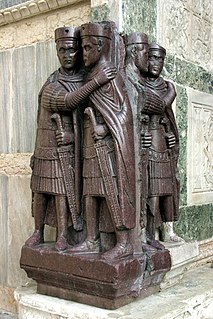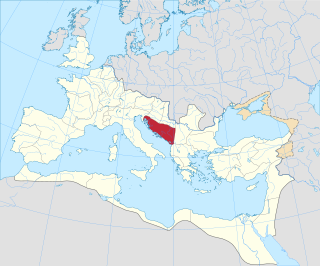
An emperor is a monarch, and usually the sovereign ruler of an empire or another type of imperial realm. Empress, the female equivalent, may indicate an emperor's wife, mother, or a woman who rules in her own right. Emperors are generally recognized to be of the highest monarchic honour and rank, surpassing kings. In Europe, the title of Emperor has been used since the Middle Ages, considered in those times equal or almost equal in dignity to that of Pope due to the latter's position as visible head of the Church and spiritual leader of the Catholic part of Western Europe. The Emperor of Japan is the only currently reigning monarch whose title is translated into English as "Emperor", although he holds no actual political power, nor is Japan an empire.

The Tetrarchy was the system instituted by Roman Emperor Diocletian in 293 to govern the ancient Roman Empire by dividing it between two senior emperors, the augusti, and their juniors and designated successors, the caesares. This marked the end of the Crisis of the Third Century.

The following outline is provided as an overview of and topical guide to ancient Rome:

The Praetorian Guard was a unit of the Imperial Roman army that served as personal bodyguards and intelligence agents for the Roman emperors. During the Roman Republic, the Praetorian Guard were an escort for high-rank political officials and were bodyguards for the senior officers of the Roman legions. In the year 27 BC, after Rome's transition from republic to empire, the first Emperor of Rome, Caesar Augustus, designated the Praetorians as his personal security escort. For three centuries, the guards of the Roman emperor also were known for their palace intrigues, by which influence upon imperial politics the Praetorians could overthrow an emperor, and then proclaim his successor as the new Caesar of Rome. In AD 312, Constantine the Great disbanded the cohortes praetoriae and destroyed their barracks at the Castra Praetoria.

The Roman emperor was the ruler of the Roman Empire during the imperial period. The emperors used a variety of different titles throughout history. Often when a given Roman is described as becoming "emperor" in English, it reflects his taking of the title Augustus or Caesar. Another title often used was imperator, originally a military honorific. Early emperors also used the title Princeps Civitatis. Emperors frequently amassed republican titles, notably princeps senatus, consul, and pontifex maximus.
Princeps is a Latin word meaning "first in time or order; the first, foremost, chief, the most eminent, distinguished, or noble; the first man, first person". As a title, "princeps" originated in the Roman Republic wherein the leading member of the Senate was designated princeps senatus. It is primarily associated with the Roman emperors as an unofficial title first adopted by Augustus in 23 BC. Its use in this context continued until the reign of Diocletian at the end of the third century. He preferred the title of dominus, meaning "lord" or "master". As a result, the Roman Empire from Augustus to Diocletian is termed the "principate" (principatus) and from Diocletian onwards as the "dominate" (dominatus). Other historians define the reign of Augustus to Severus Alexander as the Principate, and the period afterwards as the "Autocracy".

Adoption in Ancient Rome was practiced and performed by the upper classes; a large number of adoptions were performed by the Senatorial class. Succession and family legacy were very important; therefore Romans needed ways of passing down their fortune and name when unable to produce a male heir. Adoption was one of the few ways to guarantee succession, so it became a norm to adopt young males into the homes of high ranking families. Due to the Roman inheritance laws, women had very little rights or the ability to inherit fortunes. This made them less valuable for adoption. However, women were still adopted and it was more common for them to be wed to an influential family.

Caesar is a title of imperial character. It derives from the cognomen of Julius Caesar, the Roman dictator. The change from being a familial name to a title adopted by the Roman Emperors can be dated to about 68/69 AD, the so-called "Year of the Four Emperors".
The praetorian prefect was a high office in the Roman Empire. Originating as the commander of the Praetorian Guard, the office gradually acquired extensive legal and administrative functions, with its holders becoming the Emperor's chief aides. Under Constantine I, the office was much reduced in power and transformed into a purely civilian administrative post, while under his successors, territorially-defined praetorian prefectures emerged as the highest-level administrative division of the Empire. The prefects again functioned as the chief ministers of the state, with many laws addressed to them by name. In this role, praetorian prefects continued to be appointed by the Eastern Roman Empire until the reign of Heraclius in the 7th century AD, when wide-ranging reforms reduced their power and converted them to mere overseers of provincial administration. The last traces of the prefecture disappeared in the Byzantine Empire by the 840s.

The Dominate is the name sometimes given to the "despotic" later phase of imperial government, following the earlier period known as the "Principate", in the ancient Roman Empire. This phase is more often called the Tetrarchy at least until 313 when the empire was reunited.

Italia was the homeland of the Romans and metropole of Rome's empire in classical antiquity. According to Roman mythology, Italy was the ancestral home promised by Jupiter to Aeneas of Troy and his descendants, who were the founders of Rome. Aside from the legendary accounts, Rome was an Italic city-state that changed its form of government from kingdom to republic and then grew within the context of a peninsula dominated by the Celts in the North, the Etruscans and Umbrians in the Centre, and the Messapians and Greek colonies in the south.

A Roman governor was an official either elected or appointed to be the chief administrator of Roman law throughout one or more of the many provinces constituting the Roman Empire. A Roman governor is also known as a propraetor or proconsul.
The praetorian prefecture was the largest administrative division of the late Roman Empire, above the mid-level dioceses and the low-level provinces. Praetorian prefectures originated in the reign of Constantine I, reaching their more or less final form in the last third of the 4th century and surviving until the 7th century, when the reforms of Heraclius diminished the prefecture's power, and the Muslim conquests forced the East Roman Empire to adopt the new theme system. Elements of the prefecture's administrative apparatus however are documented to have survived in the Byzantine Empire until the first half of the 9th century.

The Nerva–Antonine dynasty was a dynasty of 7 Roman Emperors who ruled over the Roman Empire from AD 96 to 192. These Emperors are Nerva, Trajan, Hadrian, Antoninus Pius, Lucius Verus, Marcus Aurelius, and Commodus. The first of these before Commodus are commonly known as the "Five Good Emperors".

In the Late Roman Empire, usually dated 284 AD to 602 AD, the regional governance district known as the Roman or civil diocese was made up of a grouping of provinces headed by vicars, who were the substitutes or representatives of praetorian prefects. There were initially twelve dioceses, rising to fourteen by the end of the 4th century.

Dalmatia was a Roman province. Its name is derived from the name of an Illyrian tribe called the Dalmatae, which lived in the central area of the eastern coast of the Adriatic Sea. It encompassed the northern part of present-day Albania, much of Croatia, Bosnia and Herzegovina, Montenegro, Kosovo and Serbia, thus covering an area significantly larger than the current Croatian region of Dalmatia. Originally this region was called Illyria or Illyricum.

The constitution of the late Roman Empire was an unwritten set of guidelines and principles passed down, mainly through precedent, which defined the manner in which the late Roman Empire was governed. As a matter of historical convention, the late Roman Empire emerged from the Roman Principate, with the accession of Diocletian in AD 284, his reign marking the beginning of the Tetrarchy. The constitution of the Dominate outrightly recognized monarchy as the true source of power, and thus ended the facade of dyarchy, in which emperor and Senate governed the empire together.

The history of the constitution of the Roman Empire begins with the establishment of the Principate in 27 BC and is considered to conclude with the abolition of that constitutional structure in favour of the Dominate at Diocletian's accession in AD 284. The Roman Empire's constitution emerged as a transformation of the late Roman Republic's constitution, utilising various late Republican precedents, to legitimise the granting of incredible legal powers to one man and the centralisation of legal powers into bodies which that man controlled.

The history of the Roman Empire covers the history of ancient Rome from the fall of the Roman Republic in 27 BC until the abdication of Romulus Augustulus in AD 476 in the West, and the Fall of Constantinople in the East in AD 1453. Ancient Rome became a territorial empire while still a republic, but was then ruled by Roman emperors beginning with Augustus, becoming the Roman Empire following the death of the last republican dictator, the first emperor's adoptive father Julius Caesar.










